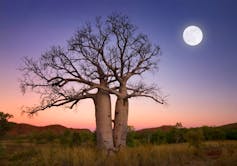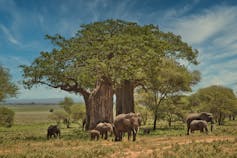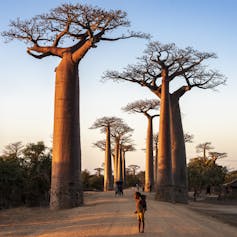There are eight species of baobab in the world, and they have a surprising distribution. Six are found in Madagascar, an island in the Indian Ocean; one is found on the continent of Africa; and the last is far away in Australia.
The origin of this group of plants has fascinated people for a long time. I joined a global team of plant genetics and genomics researchers led by Tao Wan and Qing Feng Wang of the Wuhan Botanical Gardens in China and Ilia Leitch of the Royal Botanic Gardens at Kew in London to sequence, assemble and study the genomes of all eight baobab species.
Baobabs are a remarkable keystone species, capable of supporting a wide diversity of animals for food and shelter. They can reach huge dimensions (depending on the species) in both height and diameter. The largest species can tower above the understorey vegetation. When you encounter a big African baobab on its own, it really is like “Home Tree” in the movie Avatar, not only because of its size, but also because it supports such a huge variety of life.
From an in-depth analysis of genomic data, we were able to explore how much genetic diversity there is in each species. This is important because it can indicate how resilient each species is to some of the big environmental challenges baobabs are facing, such as land use problems and climate change, and hence their risk of extinction.
Our research found that the baobabs we see today all originated in Madagascar. They started evolving to form the distinct species around 21 million years ago. Later, two of these species travelled to Africa and Australia before the lineages went extinct in Madagascar.

The evolutionary history of baobabs
In the baobab genomes, we found evidence of ancient hybridisation between species. This means they must all have lived together on Madagascar at some point, and interbred. By adding geological and palaeoclimate data, we were able to calculate that on Madagascar, different species of baobab evolved, influenced by ice ages and sea levels that rose and fell over millions of years.

The African species (Adansonia digitata), like the Australian species (Adansonia gregorii and also known as “boab”), almost certainly left Madagascar as seeds or seedlings, floating on piles of debris clumped together as rafts, that were carried out to sea by rivers swollen from flash storms. The early African baobab pioneer probably arrived within the last 12 million years.
From there it expanded in number, often with the help of elephants which eat its seeds. Many baobab seeds pass through elephants undamaged and are deposited in piles of dung, up to 65km away from where the elephant ate the baobab fruit.
We think that by the time the baobab trees spread across the continent to west Africa, a cell division mistake had occurred in the generation of the pollen or eggs, resulting in African baobab seedlings having increased chromosome numbers in their cells (from 88 to 168). Such an increase in chromosome number is common in plants and is known as polyploidy. Polyploidy is a process that genetically isolates the plant from its parents. Unlike most animals, plants can self pollinate to increase their numbers. Thus a genetic mistake, in rare circumstances, can generate a new species.
The new polyploid baobab is then likely to have become the dominant species of Africa, replacing its parent lineages across the continent. This may have happened over about 2,500 years, based on calculations of how fast elephants can move baobab seeds.
I say that the polyploid baobab replaced its parents. But did it? We are currently investigating whether the ancient form of baobab (possibly a form named Adansonia kilima) still exists in Zimbabwe and on the slopes of Mount Kilimanjaro and beyond. Scientists assumed this after an analysis of baobab leaves and chromosome numbers in those areas suggested that they came from two different baobab species. But these reports remain to be verified. Further detective work is clearly needed to track down whether Adansonia kilima, the baobab with the original chromosome number of 88, still exists.
Their astonishing growth form
Baobabs are known as “the tree of life” because they support the surrounding ecosystem and the many forms of life that live in their hollow trunks, nest on and in their branches, and eat their nectar and fruits. The root systems are massive and help to slow down soil erosion and recycle nutrients.
The massive trunks are hollow cylinders of low-quality wood containing many water-filled living cells. Some of the largest and oldest baobab trees in Australia have been estimated to hold more than 100,000 litres of water. The water-filled cells of the trunk generate a hydrostatic pressure that gives the tree strength (the water acting a bit like air in a bouncy castle).

Unfortunately for the tree, the trunk can provide water for elephants. In particularly dry seasons, trees are damaged or destroyed as elephants strip the bark to get the water in the wood. The bark is also partially resistant to fire damage, which is essential for a plant that lives in savannah.
Baobab flowers are large and have evolved alongside large nocturnal, sugar eating animals like hawk moths, fruit bats and the lemurs of Madagascar.
Why it matters

Two of the Madagascar species are already listed as endangered, based on the International Union for the Conservation of Nature Red List criteria. They exist in small numbers and can only survive in certain habitats, which are shrinking. They are not genetically diverse. We recommend that their extinction risk threat is raised to the next level, critically endangered, so that they can be protected.
Our research shows that a third, even rarer species (already assessed as critically endangered) is vulnerable to hybridisation – interbreeding with a more common species. This means that the rare species could become genetically swamped and lose its distinctiveness.
Practically, that may mean difficult conservation decisions, such as removing the commoner baobab species where they occur together, replanting the rarer baobab in suitable areas that lack the more common species, or just accepting that the two species will slowly lose their distinctiveness.
(The research that this article is based on was co-authored by Jun-Nan Wan, Sheng-Wei Wang, Ilia J. Leitch, Jian-Bo Jian, Zhang-Yan Wu, Hai-Ping Xin, Mijoro Rakotoarinivo, Guy Eric Onjalalaina, Robert Wahiti Gituru, Can Dai, Geoffrey Mwachala, Ming-Zhou Bai, Chen-Xi Zhao, Hong-Qi Wang, Sheng-Lan Du, Neng Wei, Guang-Wan Hu, Si-Chong Chen, Xiao-Ya Chen, Tao Wan and Qing-Feng Wang).

